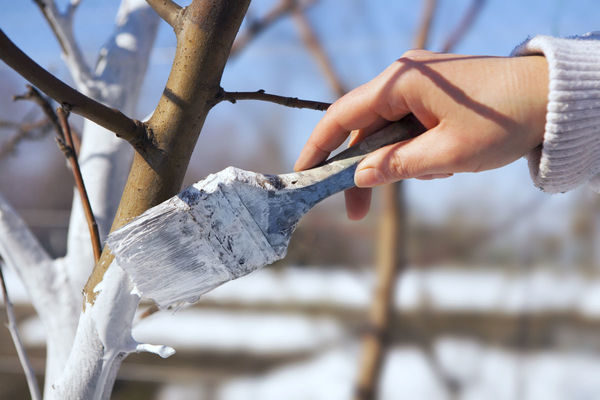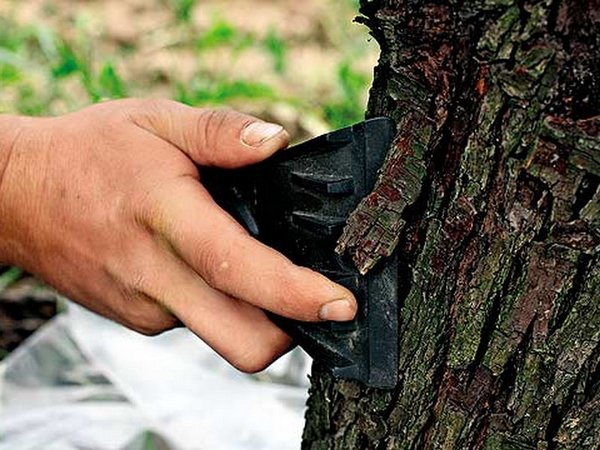Protecting the apple tree from the sun - whitewashing the trunks
Caring for garden trees, including apple trees, is very similar in essence to caring for a child. It requires constant care, attention and care. Trees need to be watered, fertilized, pruned in time and not forget about their skin - the bark. It must be whitened correctly and in a timely manner, which can protect the surface from ultraviolet radiation and pests. This is a simple process, but it requires certain knowledge and skills. Let's find out how and when to whiten the apple trees.
Content
When to whitewash
It is desirable to whitewash apple trees 2 times a year. At the same time, not only the trunk is whitened, but also the skeletal branches of the lower tier. There is a heated debate among gardeners about the timing of the procedure. Some of them are sure that it is rational to carry out it in winter. And abandon the spring, since it is absolutely not useful, but is an ordinary decoration of the garden. That it is the spring whitewashing for apple trees that clogs the pores of the bark and interferes with the natural development of the tree and can lead to its death.
Supporters of spring painting argue that it is early painting that is able to protect the bark from the action of sunlight, save it from bark beetles, in general, save the tree from environmental influences.
So when is it really true to whitewash apple trees, so that it is scientifically true and will only benefit, not harm?
Experts agree that by performing this procedure in the spring, you can save the tree from the destructive effects of the sun. Judge for yourself, in spring the weather has not yet settled down and is very changeable. During the day, the ambient temperature will be above zero, while at night it can drop below zero. The trunk has a dark color, which will actively attract the sun's rays. This will lead to the fact that the crust is actively heated during the day, and sharply cooled at night. As a result, it can crack. And if whitened in white, it will help reflect the rays. And on especially hot summer days, the white color of the trunk will not allow the plant to overheat and save its covers from burns.
Spring whitewashing protects against all kinds of pests that actively wake up after a long winter sleep. But in order to achieve maximum protection, it is necessary to whitewash according to all the rules.
A quiet spring day in March will be optimal for this procedure. The foliage has not yet begun to bloom, and the ground cover has not yet had time to warm up under the first rays of the sun, and all kinds of pests are still sleeping. After all, a defenseless bark can become an excellent shelter for them in early spring. With the help of spring whitewashing, you also get an excellent opportunity to get rid of hibernating pests in the bark of an apple tree.

An important point is also what the weather will be on the day you choose. It is desirable that it be cool and dry. Do not experiment with painting in the rain. It will wash off all the paint anyway. Also, do not delay the process. Indeed, with the onset of tangible spring warmth, this procedure is no longer advisable. You will miss the main thing - time. The bark of your trees will not be able to escape from the bright rays of the sun and will suffer from burns.
Winter is also good for painting, especially if you live in a warm, southern climatic zone or didn't spend it in the fall. You just need to choose suitable weather conditions. The main requirement is dry weather. After all, the paint layer must be absorbed and dry thoroughly. Otherwise, it will be washed away by the rains.
Whitewash solution
To the question "how to whitewash the apple trees" we most often hear the answer - with lime. To get paint, take quicklime dry lime and dilute it with water. But, of course, there are options and we will talk about them below. The composition of the solution depends on what goals you pursue when you whitewash: you want to get rid of pests or save the tree from exposure to sunlight.
A young seedling also needs bleaching, like an adult tree. But there is an assumption that young seedlings should not be subjected to this procedure. After all, paint has an irritating effect on young tree coverings and interferes with the process of thickening the trunk. But this is a very controversial aspect. After all, if you significantly reduce the concentration of lime in the water, then, of course, you will avoid such problems. It is recommended to add clay to the solution for better adhesion. It will contribute to the viscosity of your composition. If you want to experiment, get a water-based paint.
When making by hand or purchasing a ready-made solution, remember that its composition should not be very thick. It is also undesirable for the paint layer to be thick - this adversely affects the state of the apple tree. If, after painting, you notice that the whitewash is crumbling or cracking quickly, you will have to repeat everything from the beginning, taking into account the previous mistakes.
In the event that the solution flows from the trunk during the procedure, it is advisable to increase the concentration of lime and repeat the painting.
If you start painting a young plant and want to rid it of pests and all kinds of pathogens, use chalk, not lime. After all, lime, as we noted, can harm young seedlings.
Be aware that the optimal thickness of the whitewash layer should be no more than 3 millimeters. And only thanks to the homogeneous and lump-free consistency of the solution, you will achieve the desired result.
You can use ready-made solutions and alkyd paints. Such paints in their composition already contain antifungal components and an antiseptic.
Painting with iron sulfate is also popular. It promotes the formation of chlorophyll and perfectly nourishes the entire tree. For the greatest effect, add chalk or slaked lime to it.
But if you wish, you can prepare the paint yourself. The main thing is that the glue ingredients must be included in the solution. Without them, the whitewash will not be able to hold out for a long time and will be washed off at the first precipitation. Do not forget about the color of the solution. Regardless of whether it is purchased or prepared on its own, the color should be strictly white. Otherwise, such paint will not be able to protect the bark from burns.
Technology
You don't have to learn to whiten the trunk of an apple tree. This is a very simple and easy manipulation that even a child can handle. The process itself consists of two subsequent stages - preparation of the bark and staining.
Preparation consists in removing the old, dry bark from the boles. This is done with a spatula or scraper. When all the old bark has been removed, it is necessary to "grind" the tree with an iron brush. If the apple tree is young, it is enough to brush it just once. Treat the wounds received during the procedure with garden varnish or a solution of ferrous sulfate.

Next, use a wide brush or spray gun to paint. During the process, be careful, try to ensure that the solution falls on the tree trunk over the entire surface area and in an even layer.
Do not neglect caring for the bark of your apple trees - this is their "skin" and it requires a gentle, careful attitude and care. After all, the environment affects it every day. Only regular whitewashing will give positive results. Apple trees will delight you with a generous harvest and be much less sick.
How to whitewash apple seedlings (video)
This video will show you how to properly paint apple seedlings.
